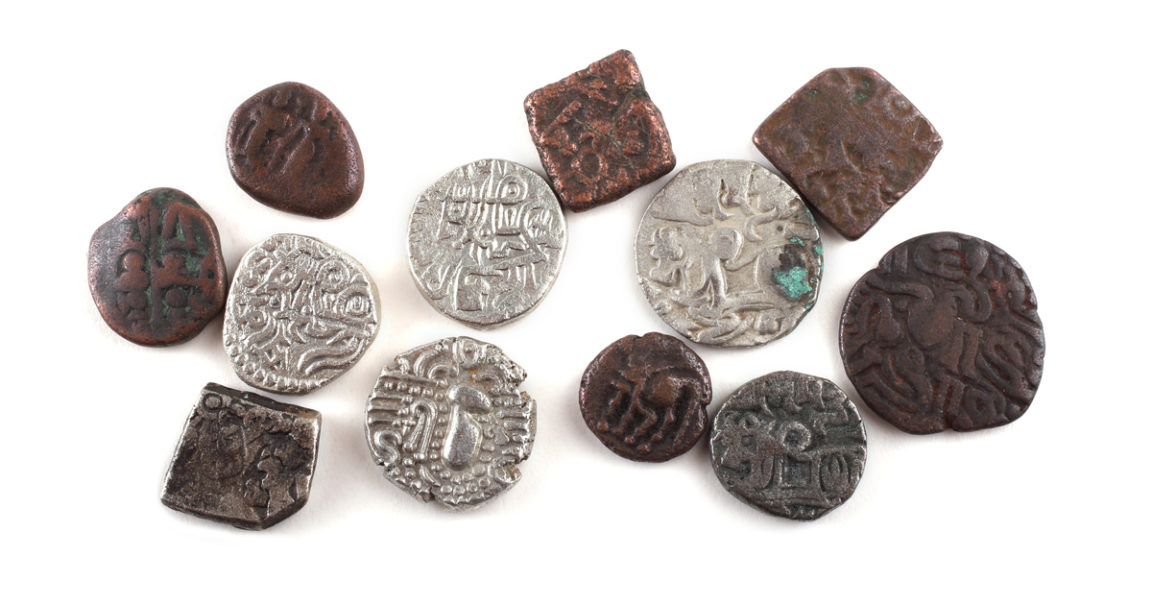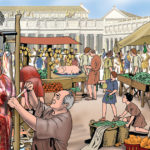Coins throughout History
Coinage is a fascinating conversation and the subject of a lot of scholarly effort. It also has some VERY dense literature. For example, the Roman Imperial Coinage series published by Spink is the subject of no less than 10 volumes and 6435 pages.1 The relatively smaller subject of coinage in the city of Corinth from its approximate introduction to the end of the Peloponnesian war only has a page count of about 504.2 Fortunately, most of this information is photos and pretty pictures, but suffice to say this subject is dense. But when did coinage become a common part of everyday society? Well, probably not surprising that is a complex question.
The “First Coins”: The Temple of Artemis and Lydian Coinage in the 6th Century
The first and simplest answer to the question is somewhere between 600 and 560 BCE. According to Herodotus, the first gold and silver coins in history were produced by the Lydians and quickly spread across the Greek world.3 This at least is partly true, one of the first precious metal coins of the Greek world was the Lydian coin, and it was made of electrum, an alloy of gold and silver. Almost immediately after this, we find coins across the Greek world, and modern coins are often considered to be a direct descendent of these early Lydian coins.
However, these may not in fact be the first coins of the ancient world. Contrary to the claims of Herodotus, the earliest coins found by archaeologists date back to the early 7th century – sometime between 700 and 660 BCE4 – and were found inside a temple of Artemis in Ephesus. Ninety-six coins were found in total, consisting of thirteen different types of coins, some incomplete coins, and nineteen which were found stored inside a small pot, each one made of electrum in the same manner as the Lydian coins.5 While it is possible, it is highly unlikely that these were “the first coins in history”. While it is possible that the temple of Artemis minted these coins themselves (thus explaining their possession of incomplete coins), the presence of no less than thirteen types of coins suggests that these coins were intended for use in an already complex system – they were not recently invented prototypes. Coin based currency must have already been in circulation, potentially as early as the 8th century.
Regardless of the exact date, by the end of the 6th-century electrum coinage of the Lydian variety (and later the Athenian variety) had become the backbone of Greek trade and the idea spread across the Ancient Near East. Phoenician coins were first minted within a decade of 600 BCE, and Judaean coins soon after.6 However, despite these advances, it was not until the end of the fifth century that many of the major empires began to use coins for anything other than direct trade with Greece. It was, effectively, like major nations storing euros or euro knockoffs just in case they need to buy something from Europe, but having no equivalent for their own country. By the start of the fourth century, however, Phoenicians, Carthaginians, Cretans, Etruscans, and Persians were all minting their own coins, using them for international trade, and circulating them within their own borders.7
Ancient Coins of India
Of all sources of coinage, India presents a most unique example. On the archaeological side, the earliest discovered coins are a hoard of more than a thousand silver pieces dating back to the late 6th century. This predates known contact with the currency of the Greek world by more than a hundred years, and the unique squarish shape denotes an independent development of the currency. We can happily conclude that the Indian concept of money developed independently from the Greek variant – although it is difficult to conclude with absolute certainty which came first.
However, the terminology used for Indian currency dates back father than the archaeological evidence. In Vedic literature, there are references to gold and prices that date back as far as the third millennium BCE. On this basis, authors Bhandarkar and Kosambi have suggested that Indian coin currency dates back at least that far, perhaps further.8 However, as the coins of India were made of silver rather than gold, it is likely that the terms pāda and Śatamāna simply referenced units of weight, later adopted into stamped metal ingots and only later coins. Notably, for much of the Indian subcontinent, cowry shells had been in use as form of currency since the third millennium.
Ancient Coins of China
The final original currency is that of ancient China. The earliest definable coins were made of bronze, shaped like a knives hole in the centre. These early “coins” had become common by the end of the sixth century. However, by the mid-fourth century, a new form of coin emerged a circular coin with a square hole. This became the national currency under the rule of Emperor Qin Shi Huang Di, the first historical emperor of China, near the end of the third century BCE.
There remains some debate, however, as to whether or not these were the first coins of the Chinese world. Archaeology has revealed a series of copper items called “spades” that operated from approximately 1045 to 256 BC, with some scholars suggesting even earlier dates. However their use as currency has been hotly debated, and at present, there is limited evidence to suggest any widespread presence of stamped and standardised coins prior to the development of the knife and disc coins of the later centuries.9
While it is tempting to believe that the coin developed in one location and travelled to others, the uniqueness of each of the three major coins, Lydian, Indian and Chinese, has led most scholars to believe that each was developed independently of the others. Although the idea for small, stamped currency could have travelled along trade routes, the inventions of each nation are so strikingly different that it is highly unlikely that any one nation’s coin directly influenced the other’s. Each type of coin was produced using an entirely different metallurgical process, electrum for the Greek world, Silver for the Indian and Bronze for China. They each had different shapes and values. But perhaps most importantly, many of the countries between these nations did not themselves develop or engage with the currency. Despite being developed first, it took over a hundred years – possibly two – for the Lydian coin to become the standard mode of exchange in the western world. Meanwhile, in both the east and the south the physical coin was invented later but adopted across their countries far more rapidly. Many scholars believe that these were each separate inventions, adaptations to the increasing complexity of a globalised economic world.
Before the Coin
From a technological standpoint, there was no reason why coins could not have come into existence hundreds of years earlier than they did – the technology, the need and to a certain extent even the idea was already prevalent in ancient society. Yet it would still take hundreds of years for the objects we now identify as coins to be invented. This is not, however, to suggest that the role of coin was not being taken up by other things. As discussed in another article, the concept of “money” or “currency” other than coins dates back to at least 3,000 BCE, according to one curious theory it may even date back as far as 7,500 BCE.10 However in the centuries prior to the advent of the coin several other items had been invented to fill that space which will quickly be touched upon here.
Babylonian and Biblical Currency: Sealed and Unsealed Silver
Old Babylonian texts refer to an object called kaspum kankum, or “sealed silver”. It has been assumed by historians that these were small ingots of silver stamped with the seal of a temple or merchant declaring their weight and value.11 This was an advantage over another currency, unsealed silver (called seror keseph in biblical texts) in use around the tenth century BCE, which had to be weighed and potentially tested every time to determine their value.12
Another biblical term, q’sitah, has also been interpreted as a form of currency. Jacob purchased the field in which Joseph was buried for 100 q’sitah, and Job’s friends gifted him a q’sitah each. However, the conclusion given by Morris Silver that this was a monetary unit used alongside the shekel is contested by later editions of the text Septigaunt, which translates the term as “ewe”, and arguably even by the text itself, which suggests the q’sitah were counted rather than weighed.13
Ancient Egyptian Currency: Deben and Piece
The standard “coin” equivalent of ancient Egypt was the deben, a piece of metal that weighed approximately 91 grams (3.2 oz). However, the Egyptians also recorded an object they called a ˇs‘ty, translated as “piece”, which weighed one-twelfth of a deben (approximately 7.6g). Egyptologist Jaroslav Cerny has suggested that these “pieces” were essentially coins, fulfilling the role and function in day-to-day life during the Ramesside era in the 13th century BCE.14 However no physical remains have ever been found, and many scholars believe that it may simply be as a unit of measurement and not a type of coin.
Ugaritic Weights and Measures
Similar to the Egyptian “piece”, Ugaritic texts have indicated that there was some sort of standardised weight and value system in place in other countries as well. In a text now known as KTU 1.14, a line reads “His tears are poured like shekels earthward, like pieces of five on the bed”. Other texts reference something called a quarter shekel. As the shekel was a unit of weight, it’s unknown if this was a reference to a specific type of object – like a ring or a coin – or whether it is an example of something metaphoric that has since been lost in translation.
Cattle as Currency
Bernhard Laum noticed in Homeric poems that the term “cattle” was often used as a measurement of price, with items priced on the basis of their value compared to cows. Similarly, the Latin word for money, pecunia, evolved from another Latin word pectus, meaning cattle. However, outside of these references there is otherwise little evidence from the ancient world that cows have ever been used as a standard unit of exchange in its own right. Laum notes this, but he also notes that bronze ingots were often made in the shape of ox hide. From this he proposed the idea that ingots of precious metal could have been used as currency for trade as an explanation for this linguistic phenomenon.15 This same idea was later taken up and expanded upon by Charles Seltman, who ultimately proposed that these ingots were the principal unit of account and exchange in the ancient world.16
Cappadocian Lead Disks
Shortly before World War 1, twelve coin-shaped lead disks were discovered during the excavation of Kal’ah Sharkat in Turkey. Sidney Smith suggested that these might be an early form of coin used by Assyrians and Cappadocians.17 However, aside from their general shape and size, there is no evidence to support this theory, and no similar objects have been found since.
Minoan Blobs
In 1901, Sir Arthur Evans discovered several small “blobs” of silver which he assessed to be a sort of archaic coin.18 He compared these with similar gold nuggets found in Cyprus and suggested that these were examples of Bronze Age currency. While they may have been used for this purpose, no further evidence has been found.
Bronze Pins
During excavations at Argos, a large number of bronze pins were discovered of varying sizes and shapes. Although potentially of ornamental or decorative value, it was posited by Charles Waldstein that these pins could have been an early form of currency.19 However, if this is the case, the lack of a seal or mark denoting the weight would suggest that these artistic pieces would have had value only measured in their weight – thus making them effectively no different from any other weight of metal.
1 Exact page numbers may vary based on edition.
2 Coupar, S. (2004) The chronology and development of the coinage of Corinth to the Peloponnesian War (vol. I&II). University of Glasgow.
3 Herodotus, Histories. I:94.
4 This dating has been attacked by various historians, with dates ranging from around 620 BCE (Robinson, E (1951). Coins from the Ephesian Artemision Reconsidered. JHS 71. 156–167) to the early 7th century on the grounds of style (Weidauer, L., (1975) Probleme der fr¨ uhen Elektronpr¨ agung. Typos, vol. 1. Office du Livre. 72-109) to the revelation that based on a revising of the archaeological evidence, they could have been hidden there anytime before 560 BCE (Bammer, A., (1990). A Peripteros of the Geometric Period in the Artemisium of Ephesus.” Anatolian Studies 40. 137-160).
5 Kraay, C., (1996). Greek Coins. Thames and Hudson. 20-22.
6 Shcaps, D., (2004). Invention of Coinage and Monetization of Ancient Greece. University of Michigan. 106.
7 Shcaps, D., (2004). Invention of Coinage and Monetization of Ancient Greece. University of Michigan. 107.
8 Bhandarkar, D., (1921). Lectures on Ancient Indian Numismatics. University of Calcutta. 70-75; Kosambi, D., (1941). On the Origin and Development of Silver Coinage in India. Current Science, 10 (9). 395-400.
9 Schaps, D., (2007). The Invention of Coinage in Lydia, in India and in China. Bulletin Du Cercle d’etudes Numismatiques, 44(1). 281-322.
10 Neiburger, E., Spohn, D. (2007). Prehistoric money. Central States Archaeological Journal. 54 (4): 188–194.
11 Shcaps, D., (2004). Invention of Coinage and Monetization of Ancient Greece. University of Michigan. 224.
12 Stern, E., (2000). Dor – Ruler of the Seas. Israel Exploration Society. 360-363.
13 Shcaps, D., (2004). Invention of Coinage and Monetization of Ancient Greece. University of Michigan. 227.
14 Cerny, J., (1954). Prices and Wages in Egypt in the Rammesside Period, Cahiers d’historie mondiale 1. 903-921.
15 Laum, Bernhard, (1924) Heiliges Geld. J. C. B. Mohr.
16 Seltman, C., (1924). Athens, Its History and Coinage before the Persian Invasion. Cambridge University Press. 1-5.
17 Smith, S., (1922). Pre-Greek Coinage in the Near East. NC 2, 176-185.
18 Evans, A., (1906). Minoan Weights and Mediums of Currency from Crete, Mycenae and Cyprus. Corolla Numismatica Essays in Honour of Barclay V. Head. Oxford University Press. 336-367.
19 Waldstein, C., (1902). The Argive Heraeum. Houghton, Miffilin, and Company. 1:61.





